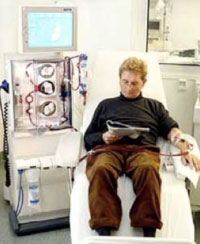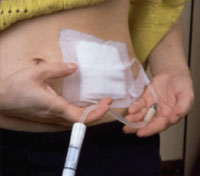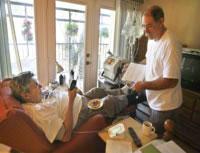Should You Become a Home Dialysis Care Partner?

When a loved one has kidney failure, your life can change, too. How much, and in what ways, can depend a lot on what type of treatment your loved one does—and on how involved you become.
The hidden burdens of in-center care
Most people whose kidneys fail in the U.S. end up on standard in-center hemodialysis (HD): three treatments per week of 3–4 hours each, on the clinic's schedule. Standard HD may seem to be easy on you. Clinic staff do all of the work, right? But what people often don't think about are:
- Job loss.
- If a loved one can't work, s/he will have less income. Social Security Disability takes 6 months of no income, and pays only about 1/3 as much as a job did. Losing a health plan means higher out-of-pocket medical costs. Loss of self-esteem and depression can occur. If you must drive your loved one to and from dialysis, your job may be in peril, too.
- Extra costs.
- People who do standard HD may need to take (and pay for) as many as 19 or more pills per day! 1 Strict diet limits may raise the grocery budget, too (and add to the cooking burden). If the clinic is far from home, gasoline costs can add up as well.
- Role change.
- Did your loved one cook? Do laundry? Mow the lawn? Load the dishwasher? Fix the car? Pay the bills? Plan family trips? If s/he is too tired to do these things now, they may fall on you. And, if you feel a need to enforce your loved one's fluid or diet limits, you may feel like a nurse or the "food police," not a partner/child/parent.
- Planning problems.
- The ups and downs of standard HD are profound. People can feel wiped out for nearly 7 hours after each treatment. 2 So, it can be hard to plan a night out or attend a special event when you never know how your loved one will feel. You may start to feel cut off from your friends or family.
- Travel troubles.
- If you enjoy travel with your loved one, standard HD can throw a wrench into your plans. It can take weeks or months to set up a travel treatment slot—and the clinic can cancel it at the last minute. Some people worry so much about trying a new center that they may refuse to travel at all.
- Sexuality and fertility.
- Are you and your loved one a couple? If so, a loss of interest in sex (or ability to perform) on standard HD can affect you. People who do standard HD are also less able to father a child or get pregnant than those who do other treatment options.
Home dialysis: What's in it for you?
 Standard HD has some real drawbacks—for you, too. What would your lives look like if dialysis
didn't
take the stuffing out of your loved one three times a week? What if s/he had more energy? Could eat and drink with fewer (or no) limits—and even help cook? What if s/he could keep working, and you could still travel? This is what may be in it for you if your loved one does home dialysis.
Standard HD has some real drawbacks—for you, too. What would your lives look like if dialysis
didn't
take the stuffing out of your loved one three times a week? What if s/he had more energy? Could eat and drink with fewer (or no) limits—and even help cook? What if s/he could keep working, and you could still travel? This is what may be in it for you if your loved one does home dialysis.
These pluses are part of "quality of life." Studies also show that—like transplant— people who get better treatment than standard HD can live longer, too. 3,4,5,6 In fact, standard HD treatments that are less than 4 hours long raise the risk of death by 42%. 7 So, you may have your loved one with you longer if you help with a home treatment.
Better dialysis options in a nutshell
What are the other, better options? One is in-center extended (nocturnal) HD. Your loved one would do three treatments per week at a clinic—but during sleep for 7–8 hours. But s/he will feel much better with twice as much blood cleaning, and may live longer, too. 8 If you can't fit or can't have a dialysis machine in your home, this can be a great choice.

Other options besides standard HD are done at home. These are:
- Peritoneal dialysis (PD)
- A soft, plastic tube is placed through the wall of the belly or chest by a surgeon. The tube is used to fill the belly with sterile fluid. Wastes and extra water flow from the inner lining of the belly (peritoneum) into the fluid. Used fluid is drained out and replaced with fresh. This is done by hand or with a cycler machine at night during sleep.
- Short daily HD (SDHD)
- Standard HD is like being on a roller coaster—but less fun. Extra water builds up in your loved one's body and is then pulled off quickly. This can cause severe, painful muscle cramps, nausea, vomiting, and headaches. With SDHD, your loved one can take off fluid 5–6 days a week. This is much more gentle—and flexible—than standard HD. A smaller, portable machine is used, which can be taken along on trips.
- Nocturnal home HD (NHHD)
- You and your loved one can gain back a lot of time when HD treatments are done at night, during sleep. NHHD removes the most water and wastes of any type of dialysis. Fewer meds are needed and a normal diet and fluids are possible. It can even reverse some heart damage. 9 NHHD can be done 3–6 nights per week with a standard or a portable machine.
What would I have to do?
First, don't panic! The idea of being a care partner for someone on dialysis can be scary. But no-one goes home without a thorough training course, and clinics have 24-hour phone back-up. You are never alone.
Notice that we said care partner, NOT caregiver. There's a reason for this. Studies show that home treatment works best when the person on dialysis does as much of the work as possible. 10,11,12 Not you!* Most home HD programs (and a few PD ones) require a partner to go through training with the person on dialysis. But it's vital to be clear up front about what your role will be and how much you will do vs. your partner.
Starting home dialysis is like bringing home a new baby. You lose some control until you set up routines. There are things to find room for and new tasks that need to be done. It's hard and very stressful at first! And then things get easier as you get used to them.

Talk with your partner and the home training nurse about what to expect. And give yourself time to adjust. One care partner suggests clearing your calendar during training. This way, you can leave yourself time to get used to things.
*NOTE: Someone who is very frail, obese, not mobile, has lost limbs, etc., may need total care. Medicare does not pay for home dialysis helpers. If it is easier for your family to care for a very high-needs loved one at home than to bring him or her to and from a clinic three times a week, you would be doing all of the work.
Divide home dialysis tasks
Many people do PD alone, with no helper. Some people do SDHD or NHHD alone, too. This means that as a care partner, you may be able to do very little—even zero. You may want to help out, at least a bit. Being on-site during treatments as an extra pair of hands may ease your mind, for example. Or, you may choose to do more, or need to do more if your loved one can't do everything.
Here are some of the tasks that one of you will need to do:
- Organize supplies so they are easy to find
- Unload new supplies that arrive
- Keep track of supply amounts for orders
- Gather supplies needed for a treatment
- Set up the machine, test all alarms
- Test water treatment devices, if present
- Take vital signs before/after a treatment
- Clean the access
- Put in needles or connect the catheter
- Start the treatment and monitor it
- Troubleshoot any problems that occur
- Draw blood for lab tests
- Keep treatment logs and send them in
- Remove needles or disconnect catheter
- Hold needle sites if needles were used
- Clean the machine and discard trash
You and your loved one will need to decide who will do which tasks. Over time, you may need to renegotiate if things change.
The treatment schedule can—and should—also be decided ahead of time, if possible. SDHD treatments can be done at any time of day. The times your loved one chooses need to work for both of you, if you have a role in the treatment. It's not fair to hold your schedule hostage by picking a time at the last minute.
Putting dialysis needles in is something your loved one should do unless s/he can't reach or does not have the use of his or her hands. It is best if you don't have to do this task (though taking out the needles can require some help). If you must be the one who will put in the dialysis needles, it may help you to:
- Use the Buttonhole technique ( learn more ). This means forming scar tracts by using the exact same holes and exact same angles for 8 or so treatments in a row. The tracts act like pierced earring holes to guide the needles into just the right spot with very little pain.
- Know that when only one person puts needles in a dialysis access, it can last for years or even decades. And the chance of infection or a blood clot is much lower.
Strong couple relationships can grow stronger

Working as a team to make home dialysis possible for your loved one can bring you closer together. If you are a couple and had a strong relationship before, it can even help make you stronger. Some say that the extra couple time is a big plus as well. Good communication is vital.
Some fun things you and your loved one can do to keep your relationship healthy include:
- Appreciation
- Say "thank you," or "I appreciate that you..." when your loved one does something nice for you. (Folks on dialysis: this includes thanking your partner for helping with treatments!)
- Backrubs (or other gestures you agree on)
- Trading backrubs, holding hands, hugs...all express love through touch.
- Communication
- Share your dreams. Talk about your feelings. Plan for the future. Catch up with each other.
- Dates
- Spend some couple time doing something fun that you both enjoy. Be sure that your time isn't only spent talking about and doing dialysis. (You don't have to spend a lot of money on a date. Grocery shopping can be a date if you enjoy it and agree that it counts.)
- Eye contact
- Make a point of looking at your loved one when you talk to him or her. Smile! You'll both feel closer when you do.
Conclusion
If your loved one is on dialysis, think about being a home care partner. Better dialysis treatments can benefit both of you.
References:
- Chiu Yw, Teitelbaum I, Misra M, de Leon EM, Adzize T, Mehrotra R. Pill burden, adherence, hyperphosphatemia, and quality of life in maintenance dialysis patients. Clin J Am Soc Nephrol. 2009 Jun;4(6):1089-96.
- Lindsay RM, Heidenheim PA, Nesrallah G, Garg AX, Suri R. Daily Hemodialysis Study Group London Health Sciences Center. Minutes to recovery after a hemodialysis session: a simple health-related quality of life question that is reliable, valid, and sensitive to change. Clin J Am Soc Nephrol. 2006 Sep;1(5):952-9.
- Weinhandl ED, Foley RN, Gilberson DT, Arenson TJ, Snyder JJ, Collins AJ. Propensity-matched mortality comparison of incident hemodialysis and peritoneal dialysis patients. J Am Soc Nephrol. 2010 Mar;21(3):499-506.
- Johansen KL, Zhang R, Huang Y, Chen S-C, Blagg CR, Goldfarb-Rumyantzev AS, Hoy CD, Lockridge RS, Miller BW, Eggers PW, Kutner NG. Survival and hospitalization among patients using nocturnal and short daily compared to conventional hemodialysis: a USRDS study. Kidney Int. 2009;76:984-90.
- Pauly RP, Gill JS, Rose CL, Asad RA, Chery A, Pierratos A, Chan CT. Survival among nocturnal home haemodialysis patients compared to kidney transplant recipients. Nephrol Dial Transplant. 2009 Sept;24(9):2915-9.
- Kjellstrand CM, Buoncristiani U, Ting G, Traeger J, Piccoli GB, Sibai-Galland R, Young BA, Blagg CR. Short daily haemodialysis: survival in 415 patients treated for 1006 patient-years. Nephrol Dial Transplant. 2008 Oct;23(10):3283-9.
- Brunelli SM, Chertow GM, Ankers ED, Lowerie EG, Thadhani R. Shorter dialysis times are associated with higher mortality among incident hemodialysis patients. Kidney Int. 2010 Apr;77(7):630-6.
- Lacson E Jr, Wang W, Lester K, Ofsthun N, Lazarus JM, Hakim RM. Outcomes associated with in-center nocturnal hemodialysis from a large multicenter program. Clin J Am Soc Nephrol. 2010 Feb;5(2):220-6.
- Chan C, Floras JS, Miller JA, Pierratos A. Improvement in ejection fraction by nocturnal haemodialysis in end-stage renal failure patients with coexisting heart failure. Nephrol Dial Transplant. 2002 Aug;17(8):1518-21.
- Atcherson E. Home hemodialysis and the spouse assistant. J Am Assoc Nephrol Nurses Tech. 1981;8:29-34.
- Marshall JR, Rice DG, O'Mera M, Shelp WD. Characteristics of couples with poor outcome in dialysis home training. J Chron Dis. 1975;28:375-381.
- Streltzer J, Finkelstein F, Feigenbaum H, Kitsen J, Cohn GL. The spouse's role in home hemodialysis. Arch Gen Psychiatry. 1976;33:55-58.

